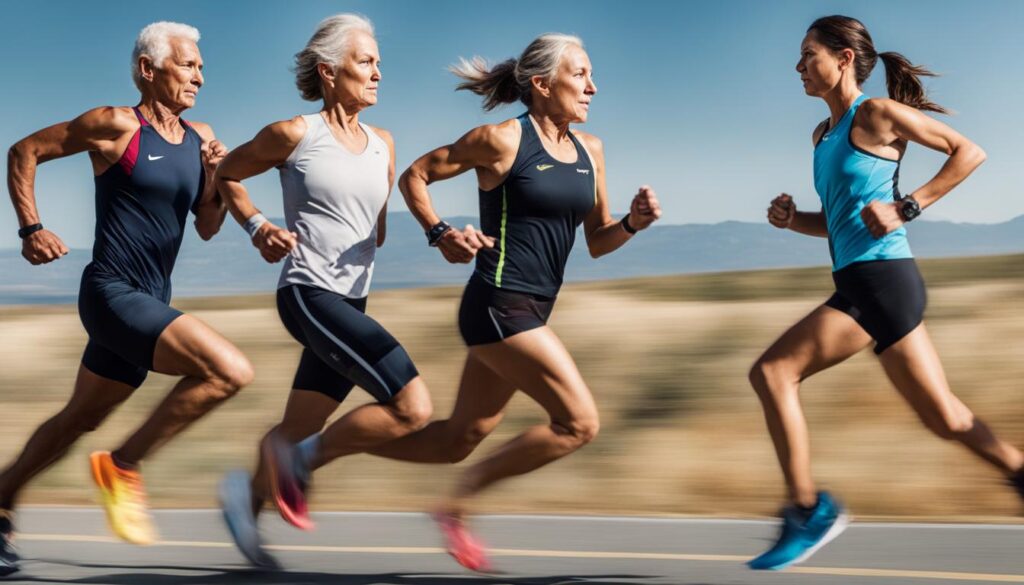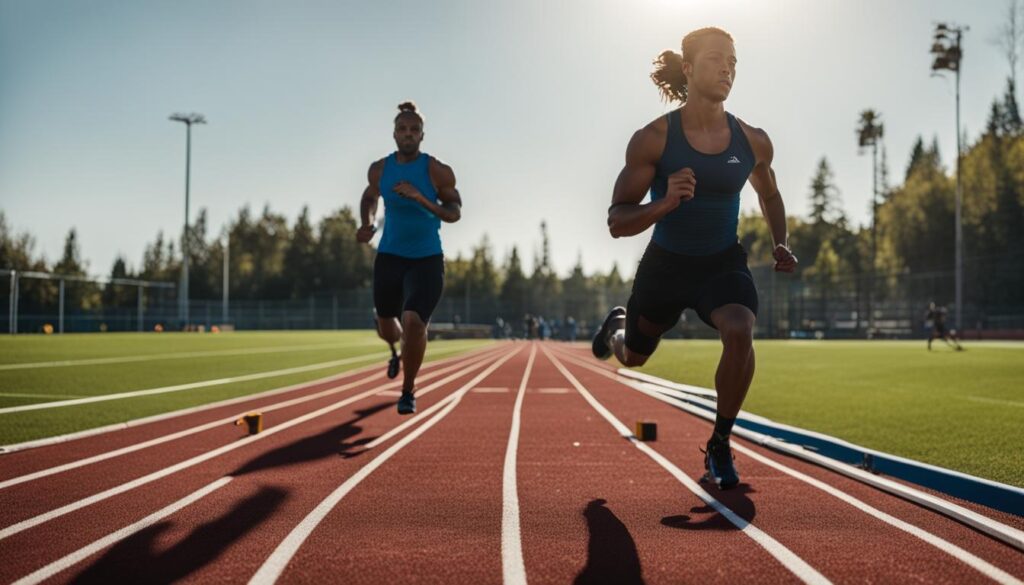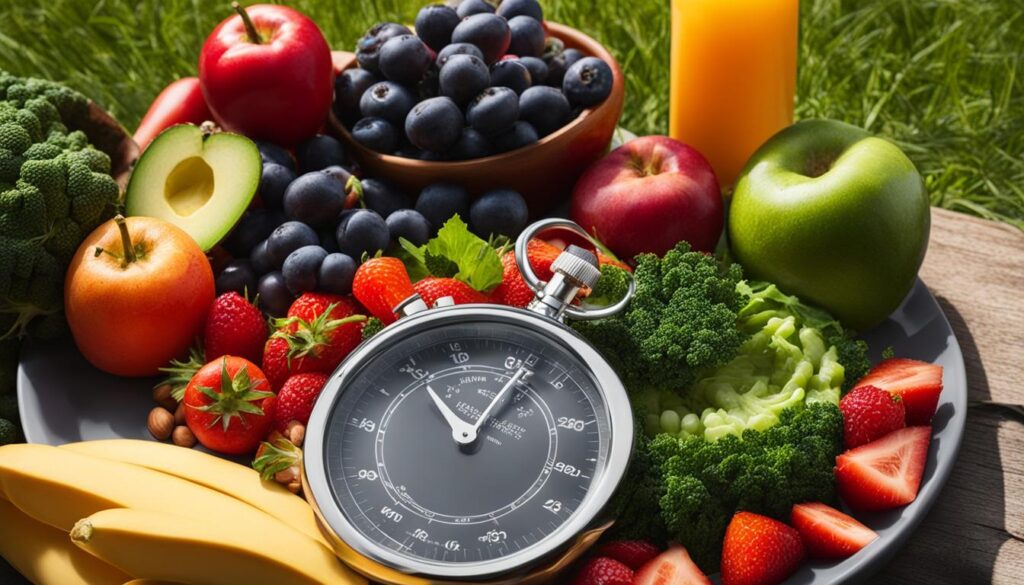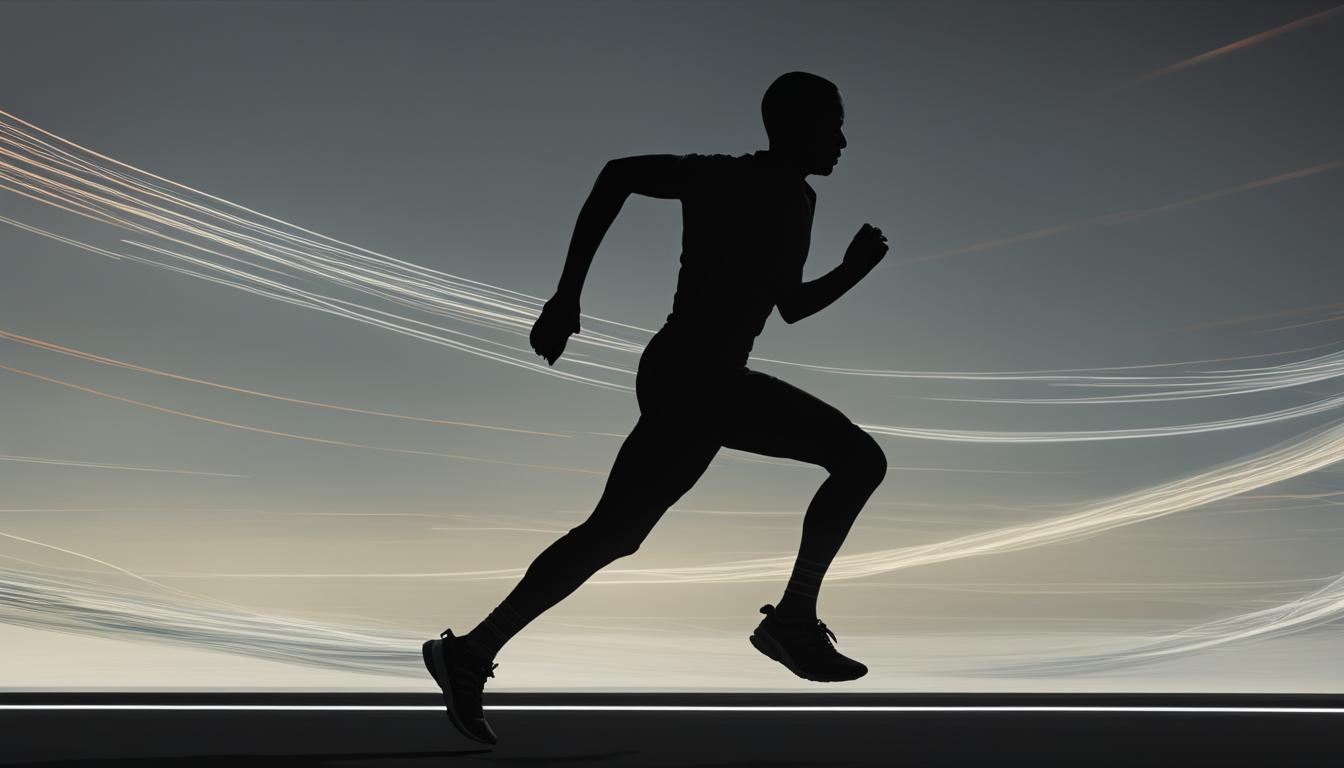For many runners, the journey doesn’t simply end as the years add up. The quest for improving speed with age remains a driving force for seasoned athletes who defy the ticking clock. Contrary to widespread belief, maintaining running performance as you grow older is not just wishful thinking. Indeed, with deliberate training efforts and scientifically backed methods, running faster with age is an achievable feat.
Challenging the natural progression of time, avid runners are continually finding ways of increasing running speed as you get older. While the body invariably undergoes changes, there are substantial measures that can be taken to bolster running economy and enhance overall performance on the track. Let’s delve into how age can become just a number for seasoned runners seeking to preserve, or even accelerate, their pace.
Key Takeaways
- Strategies for improving speed with age despite natural physiological changes.
- Methods to ensure maintaining running performance as you grow older.
- Perspectives on running faster with age through scientific and practical approaches.
- Insights into the realistic potential for increasing running speed as you get older.
- Facts about how consistent training adaptations contribute to longevity in running.
- Understanding the impact of diet, recovery, and strength training in sustaining speed.
The Influence of Age on Running Speed
As time ticks forward, the interplay between aging and running becomes a topic of increasing interest for those looking to understand how the passage of years affects athletic prowess. The body’s capacity for enduring and swift movement evolves with age, leading to observable changes in running speed in older individuals.

Aging naturally imposes a biological tariff on the body’s systems, influencing running ability with age. The quintessential peak for athletic endeavors, including running, is ostensibly captured within the ages of 20-35. Post this golden window, the decline in physical faculties, such as endurance and strength, begins its ascent, thereby impacting age and running performance.
Dr. Paola Wood, reflecting on longitudinal studies, highlights that ageing engenders a linear downturn in running velocity post-30 years, with a sharper descent as one ventures into the 60-70 age bracket.
Anecdotal evidence and empirical research converge on the principle that lifelong athletes, or those incorporating consistent activity from an early stage, may enjoy a modest hedge against this decline. However, they are not exempt from the universal trend, as the rate at which performance declines pegs itself closely to chronological aging, regardless of one’s historical activity levels.
- Muscle mass and its quality plays a pivotal role in sustaining running speed as we age.
- Some reduction in performance is inevitable, but the degree and pace at which it unfolds are modifiable with consistent training and lifestyle choices.
- Age-differential strategies must be adopted by runners to tackle the multifaceted challenges imposed by aging.
In summary, while age inevitably hampers the fleetness of our running strides, there exists a constellation of factors, modifiable through lifestyle, that can temper the pace of this decline. The running ability with age can be gracefully maintained, perhaps not at the zenith of youthful performance, but in a manner that celebrates the resilience and potential of the mature athlete.
Understanding the Age-Related Decline in Sprint Speed
Sprint speed diminishes with age, a fact that athletes and enthusiasts must tacitly acknowledge. This age-related decline in running speed is chiefly the consequence of intricate physiological changes that occur within the body over time. A closer examination of the factors affecting running speed in older individuals reveals that adaptations in muscle composition and neuromuscular function play pivotal roles.

The Impact of Muscle Composition
As we age, the once robust architecture of our muscles undergoes significant alterations. Notably affected is the quantity of fast-twitch fibers or Type II muscles, which are paramount in sprinting and activities requiring explosive power. A shift toward a higher proportion of slow-twitch, or Type I muscles, is noted with increasing age. This transition from a preponderance of fast-twitch to slow-twitch muscle fibers directly correlates with reduced sprint speed and aging.
| Age Group | Percentage Decrease in Fast-Twitch Muscles | Percentage Decrease in Muscle Strength |
|---|---|---|
| 30-50 years | 8-10% | 12-15% |
| 50-70 years | 10-20% | 15-25% |
| 70+ years | Up to 30% | Up to 30% |
Neuromuscular Communication Breakdown
A lesser-discussed but equally influential factor is the neuromuscular communication breakdown that shadows the aging process. The once seamless conversation between neurons and muscles, essential for initiating rapid muscle contraction, becomes discordant with age. Consequently, the decline in neuro-efficiency spells a decline in the strength and velocity of muscle contractions, further implicating sprint speed and aging in a tangled web of physiological complexity. This decline in neuromuscular efficiency underscores the sprint speed concerns of older runners, as each step taken fails to mirror the vivacity of youth.
Is it Possible to Run Faster as You Get Older?
The question of maximizing running speed as you age sparks a vibrant discussion among the running community. Many aspiring and experienced runners alike wonder if the pursuit of faster times is a realistic goal for the aging athlete. The good news is that a definitive ‘yes’ resonates from various studies and expert opinions when discussing maintaining running speed as you age. The key lies in the recognition and adaptation to the body’s evolving needs through strategic training methods.
First and foremost, it’s essential to acknowledge that running performance in older adults faces a myriad of physical challenges. These include a natural decrease in flexibility, a decline in lean muscle mass, and a reduced capability for the body to uptake and utilize oxygen efficiently. Nevertheless, these setbacks do not spell the end of improvements on the track or road for the dedicated runner. Effective countermeasures, tailored to enhance the older runner’s physiology, can indeed support improving running speed with age.

To buttress running speed, older athletes should embrace a combination of plyometrics and anaerobic training. These forms of exercise hone the body’s explosive power and sustain its ability to execute quick, forceful movements, which are paramount for enhancing pace. For instance, incorporating box jumps, skipping exercises, or short hill sprints can greatly contribute to an increased running cadence.
Studies show that high-intensity interval training (HIIT) can yield significant cardiovascular benefits without placing undue stress on the joints, making it a favorable option for aging runners looking to boost their speed and endurance.
Another vital component is a thoughtfully designed stretching routine, to be performed both before and after running sessions. The focus here should be on dynamic stretching pre-run to prepare the muscles for activity and prevent injuries, while post-run, the emphasis should switch to static stretches to enhance flexibility and facilitate recovery.
- Pre-run: leg swings, walking lunges, and arm circles
- Post-run: hamstring stretch, calf stretch, and quadricep stretch
Integrating these strategies into a regular training regimen can provide a supportive structure for the running enthusiast who refuses to let age dictate their pace. By maximizing running speed as you age through tailored exercises and routines, it is not only possible to maintain but potentially even to improve your running prowess, making each stride a testament to the enduring spirit of the aging runner.
Running Performance and Aging: Men vs. Women
As runners enter their forties and beyond, the topic of running performance and aging becomes increasingly relevant. A crucial aspect of this discussion is understanding how physiological changes due to aging affect running speed and how these effects differ between male and female athletes. Emerging research provides insights into age limitations on performance and prompts a deeper consideration of the running performance differences between men and women.
The decline in running speed with aging does not occur identically across genders. Notably, men tend to see a more significant decrease in running pace during their middle-age years compared to their female counterparts. This difference may stem from a variety of factors, including but not limited to, hormonal changes, training intensity, and muscle composition.
| Age Range | Men Performance Decline | Women Performance Decline |
|---|---|---|
| 40-50 | Noticeable Decrease | Mild Decrease |
| 50-60 | Accelerated Decrease | Steady Decrease |
| 60+ | Sharpened Decrease | Gradual Decrease |
The implications of these findings are significant for both male and female athletes aiming to maintain or improve their running performance amidst the challenges of aging. Not only do they reinforce the need for tailored training and recovery strategies, but they also provide a foundation for setting realistic performance goals based on comprehensive knowledge of age-related physiological differences.
“While both men and women experience declines in running performance with age, the trajectory of this decline is not parallel between the sexes. It is paramount that we delve into these variances to optimize training methodologies and extend the athletic longevity for all runners.” – excerpt from recent sports science publication.
Dissecting the male and female running performance differences can empower runners to adopt more effective, gender-specific strategies for conquering the age limitations impacting their running speed. Clear insights into the role of gender in athletic performance with aging can ultimately contribute to a thriving, inclusive running community for masters athletes.

Acknowledging that these trends are generalities and individual experiences may vary, it’s evident that the convergence of exercise science and gerontology continues to provide valuable information regarding how senior athletes can defy the odds and pursue excellence in their running endeavors.
Training Techniques to Maintain and Improve Speed
As the years pass, staying fleet-footed isn’t just a challenge, but also an opportunity for aging runners seeking to maintain or improve their running pace. Incorporating training techniques for faster running in aging individuals, understanding the importance of maintaining speed in aging runners, and integrating resistance training for runners are fundamental to outrunning the clock. A blend of resistance training and regular sprinting sessions can significantly aid in preserving and even boosting speed and agility.
The Role of Resistance Training
For those aiming to defy age-related slowdowns, resistance training stands as a cornerstone. This form of training can drastically reduce the pace at which muscle mass and quality decline, an inevitable part of aging. Resistance exercises focused on improving muscle size, strength, and power not only build endurance but also enhance metabolic rates, which is essential for speed. To further benefit aging runners, exercises aimed at improving balance, stability, and reflexes, such as single-leg squats or deadlifts, should be a staple part of their weekly routine.
Importance of Regular Sprinting
To complement resistance training, regular sprinting is indispensable. It stimulates fast-twitch muscle fibers and sharpens one’s neuromuscular efficiency, both critical for quick starts and sustaining high speeds. Aging individuals can integrate short-distance sprints into their training regimen, which can gradually lead to improved performance during longer running sessions. These bursts of high-intensity running not only invigorate the body but also challenge the mind, keeping the spirit of competition alive.

The incorporation of these trainings must be systematic and progressive to prevent injuries and ensure continual improvement. Renowned runners and trainers advocate for a mix of lower and upper body workouts, emphasizing exercises like the leg press, bench press, and bicep curls tailored to individual capabilities. Tracking progress and adjusting routines accordingly is as important as the training itself. With the right approach, aging runners can rewrite the narrative, transforming their golden years into a time of speed and vitality.
The Anatomy of Aging: Muscle Mass and Bone Density
Understanding the dynamics of aging and body composition provides valuable insight into the importance of lifestyle choices impacting long-term health. A notable decrease in muscle mass is one of the significant changes that occurs with advancing age, commencing around the third decade of life. Research indicates that these alterations are compounded biologically with a corresponding increase in fat mass, particularly around the abdominal region, escalating the risk for chronic diseases.

The age-related changes in body composition manifest differently across genders, with hormonal shifts further influencing these developments. The decline in bone density becomes more pronounced post-menopause in women, a concern that amplifies the importance of early and ongoing intervention strategies.
- Regular weight-bearing and strength training exercises
- Adequate protein intake and maintaining a balanced diet
- Supplemental calcium and vitamin D, as per medical advice
These proactive steps can be vital in mitigating the decrease in bone density with age, while also working against the grain of muscle loss and fat gain. The preservation of a healthy body composition through these adaptive strategies is indicative of the power individuals hold in influencing their aging trajectory.
“Investing in our health early on can dramatically change the narrative of aging, transforming it into a phase of life marked by vitality and strength as opposed to inevitable decline.”
Vigilance and consistency in addressing these age-related changes are indispensable for sustaining a quality of life where one can not only live longer but live better with age. Thus, an informed and active approach towards managing body composition plays a crucial role in the graceful and healthy progression through the later chapters of life.
Age and Running Ability: Mitigating the Inevitable
As we delve into the realm of mitigating age-related decline, it’s essential to recognize that running athletes can continue to thrive by maximizing running speed in the older population. Although aging is a natural process, there are formidable strategies that can support runners in overcoming running limitations with age, fostering not just maintenance, but progression in their athletic pursuits.
Strength training surfaces as a bastion for those seeking to uphold their performance. By engaging in regular, targeted workouts, older runners can preserve and enhance muscle mass, an integral factor in sprinting efficacy and endurance. Cross-training complements these efforts by offering a form of exercise that reduces the usual impact on the runner’s joints, simultaneously developing cardiovascular, strength, and flexibility capabilities.
A carefully tailored recovery approach is paramount, especially as the body necessitates more downtime for tissue repair and rejuvenation with age. This strategy could include variations in rest durations and the integration of techniques such as foam rolling or massage therapy, all catering to the runner’s evolved physiological requirements.
- Resistance Training: A structured regimen includes both heavyweight exercises for muscle building and lighter, high-repetition workouts for muscular endurance.
- Functional Training: Exercises that mimic real-world activities and movements, fortifying muscles to perform daily tasks effortlessly and reducing injury risk during runs.
- Effective Cross-Training: Alternating between cycling, swimming, and elliptical workouts to enhance cardiovascular health while reducing impact-related running injuries.
In essence, with the correct application of these principles, the narrative shifts from solely aiming to offset decline to actively augmenting running prowess, irrespective of age-based stereotypes. It rewrites the expectations for aging runners, offering a pathway to sustained and elevated performance levels.
Running Faster with Age: A Scientific Perspective
Exploring the interconnection of age and running speed reveals a fascinating realm where science and stamina converge. For aging runners, plyometrics and power training offer a beacon of hope, promising the retention of vitality and endurance. The integration of these techniques into regular training regimens has shown quantifiable improvements in flexibility and mobility—a duo critical for sustaining the elegance of stride inherent to seasoned runners.
Plyometrics and Power Training
Plyometrics for aging runners are not just exercises; they are the catalysts of transformation that ignite the explosive power crucial for peak performance. These dynamic routines are foundations that forge the athletic prowess needed to overcome the gravitational pull of age, allowing runners to maintain their speed and vigor. Power training benefits extend beyond endurance, as they revitalize the very essence of an athlete’s ability to excel.
Enhancing Flexibility and Mobility
As the body’s natural flexibility and mobility begin to wane with time, incorporating practices such as yoga and Pilates becomes paramount. These disciplines are vessels through which aging runners can navigate the vicissitudes of time, preserving the natural running gait that once seemed indelible but now requires conscious effort to maintain.
| Training Component | Expected Benefits | Suggested Activities |
|---|---|---|
| Plyometrics | Increased explosive power and speed | Jump squats, box jumps, skipping |
| Power Training | Improved strength and muscle endurance | Kettlebell workouts, hill sprints |
| Flexibility Exercises | Greater range of motion and injury prevention | Yoga, Pilates, dynamic stretching |
| Mobility Work | Enhanced joint movement and efficiency | Lunges, hip circles, leg swings |
Commencing a journey into plyometrics, power training, and flexibility regimes serves not just as a testament to the relentless spirit of aging runners, but also as a defiance of the conventional wisdom that equates growing older with slowing down. This steadfast quest to sustain and improve one’s pace is a challenge to the very age and running speed relationship that many view as unalterable.
Running Speed in Older Individuals: Diet and Nutrition
To sustain running speed with age, an optimal blend of diet and nutrition is critical. Grasping the importance of diet and nutrition in running is essential for older runners aiming to maintain, or even increase, their athletic performance. Strategic nutrition intervenes to support bodily changes and muscle maintenance, proving its pivotal role in an active lifestyle.
Protein Intake for Muscle Repair and Growth
As we age, muscle repair and growth become paramount, and protein takes center stage in this biological process. Higher protein intake for older runners is beneficial due to its role in muscle maintenance and recovery post-exercise. This is especially germane considering the inevitable loss of muscle mass with age. A diet rich in lean meats, dairy, legumes, and fish provides the amino acids necessary for protein synthesis and muscle health.
The Role of Micronutrients in Athletic Performance
Micronutrients play a substantial role in overall health and can significantly impact the athletic longevity of runners. The presence of vitamins B6 and B12, vitamin C, folate, and magnesium are all involved in energy production and the synthesis of proteins, which feed into sustained running performance.
A prudent selection of micronutrient-dense foods can make a significant difference. Below is a table that suggests some common foods high in the micronutrients vital for older runners:
| Micronutrient | Significant Sources | Role in Running |
|---|---|---|
| Vitamin B6 | Chicken, bananas, potatoes | Protein metabolism and red blood cell production |
| Vitamin B12 | Shellfish, fortified cereals, dairy products | Energy production and maintaining healthy nerve cells |
| Vitamin C | Citrus fruits, bell peppers, broccoli | Collagen synthesis and immune system support |
| Folate | Leafy greens, legumes, seeds | Cell division and DNA synthesis |
| Magnesium | Nuts, whole grains, spinach | Muscle function and protein synthesis |
Including these foods into one’s diet can ensure that the body receives the micronutrients required to support running speed and endurance as one ages.

Age-Related Changes in Running Speed: Adapting Your Training Regimen
Understanding age-related changes in running speed is crucial for runners looking to maintain their performance as they age. Adapting training with age involves strategic alterations to one’s running routine to align with the body’s evolving needs. For seniors and veteran runners, making running training adjustments is not only about preserving speed but also about ensuring health and longevity in the sport.
As explosive power and recovery times change with age, high-impact workouts should be balanced carefully. It is recommended to minimize the volume while keeping the intensity, to stay efficient without overstraining the aging muscles and joints. Recovery periods are essential and should be increased to allow for complete healing and strength rebuilding.

Incorporating cross-training activities such as cycling, swimming, or walking can offer a reprieve from the high-impact nature of running while still contributing to overall aerobic fitness. Moreover, to address the specific needs that come with an aging body, runners should focus on supplemental workouts that fortify the core and improve flexibility, therefore reducing the risk of injury. To illustrate, here’s a simplified snapshot of how a training regimen may evolve over time:
| Age Bracket | Focus Area | Training Example |
|---|---|---|
| 40-50 | Maintaining Muscle Mass | Strength training twice a week. |
| 50-60 | Balance and Stability | Yoga or Tai Chi sessions regularly. |
| 60+ | Flexibility and Recovery | Extended warm-up routines and emphasis on rest days. |
It is also worth noting that weight-bearing exercises contribute significantly to bone density, which is particularly important for older runners. An exercise regimen that includes moderate weight-training can help mitigate the age-related decrease in bone density, complementing the running schedule.
The key to success in adapting training with age lies in individualization and mindful progression. As runners progress through different decades, they must continually reassess their capabilities and adjust their training regimen accordingly, always prioritizing their health and well-being.
Overcoming Running Limitations with Age Through Recovery Strategies
For the seasoned runner, striking the right balance between training and recovery is crucial for sustained performance. As the body ages, its ability to recuperate from physical exertion lengthens, prompting the need for strategic recovery strategies for older runners. This enhanced focus on post-workout recuperation aims to maintain both speed and endurance in the face of the natural aging process.
Adjusting Recovery Periods to Combat Fatigue
Recognizing the signals of an aging body means adjusting recovery periods accordingly. Older athletes should consider elongating rest times between high-intensity runs or workouts, as doing so can significantly reduce the risk of injury and overtraining. It isn’t merely about increasing rest days, but also including light activity sessions to facilitate active recovery and keep the muscles engaged.
Importance of Sleep in Athletic Recovery
When discussing athletic recovery with age, sleep must not be overlooked. The importance of sleep for runners cannot be understated, as it is during this time that the body undergoes the most profound repair and recovery processes. Quality sleep contributes to hormonal balance, healing of strained tissues, and overall athletic readiness. Ensuring older runners obtain adequate and restful sleep is a non-negotiable aspect of a successful recovery regimen.
To illustrate the practical application of these concepts, the following table outlines recommended strategies for optimizing recovery with age:
| Recovery Method | Description | Benefits |
|---|---|---|
| Extended Cooldown Period | Gentle stretching and light activity post-exertion. | Facilitates gradual decrease of heart rate, prevents stiffness. |
| Ample Sleep | Quality rest of 7-9 hours per night. | Enhances muscular repair, mood, and cognitive function. |
| Active Recovery Days | Inclusion of low-intensity exercise on non-run days. | Encourages blood flow, nutrient delivery, and flexibility. |
| Hydration and Nutrition | Adequate fluid intake and balanced diet rich in proteins and antioxidants. | Supports muscle recovery and reduces inflammation. |
By combining these recovery strategies, older runners can effectively tackle the increased requirement for rest and repair, ultimately helping them maintain their passion for running well into their later years.
The Role of Technology and Equipment in Advancing Running Performance with Age
The evolution of technology in running performance has markedly transformed the landscape for athletes, particularly as they age. From state-of-the-art running equipment for older athletes to the substantial advances in running technology, older runners now have access to a suite of tools designed to propel their performance forward, mitigate injury risks, and enhance training efficacy.
Modern running gear encompasses footwear engineered with advanced cushioning and support, tailored for the unique needs of an aging body. Athletic apparel integrates flexible, breathable materials providing both comfort and compression, aiding in circulation and muscle support. The importance of these advancements lies not only in performance optimization but also in safety and injury prevention – two areas of heightened concern for the senior runner.

Monitoring tools and wearable technology have become integral in quantifying workout intensity, tracking progress, and setting measurable goals. Gadgets such as GPS watches and heart rate monitors provide real-time feedback, enabling older athletes to train smarter by staying within optimal heart rate zones, thereby decreasing the likelihood of overexertion.
- GPS Watches: Offering route tracking, pace monitoring, and endurance statistics
- Heart Rate Monitors: Allowing for meticulous control over training intensities
- Smart Insoles: Delivering data on stride length and foot impact to fine-tune running form
Moreover, smartphone applications paired with these devices have revolutionized how training plans are built, monitored, and adjusted. The comprehensive data collected by such technology allows for a more personalized approach to training, ensuring the regimen scales with an individual’s capacities and goals.
Another prominent feature in the toolkit of older athletes is recovery technology – innovative devices such as percussive massagers and compression sleeves are being utilized to expedite recovery times and enhance muscle recuperation, elements that are becoming increasingly necessary as recovery periods extend with age.
In summary, the intersection of technology and physical training opens a myriad of opportunities for older runners to surpass traditional limitations and continue to thrive. By embracing the innovative running equipment and advances in running technology, longevity in the sport is not just a possibility, but a tangible reality for today’s athletic elders.
Athletic Longevity: Increasing Running Speed in Older Adults
The concept of athletic longevity is testament to the notion that age does not prohibit one from achieving impressive feats in running performance. With seniors showcasing remarkable running speed in older age, it’s clear that the decline in physical capacity often associated with aging can be substantially mitigated. Understanding the strategies for prolonging running efficacy is essential for seniors who aim to not just maintain but improve their athletic prowess.

Case Studies in Running Performance over 50
Encouraging examples of running success stories in later life, such as a septuagenarian completing a 10K in a stunning 48 minutes, serve to motivate and inspire. These case studies underscore that with the correct regimen, athletic longevity isn’t a mere aspiration but an achievable reality. They highlight individuals who have defied the odds, not simply through innate talent, but via dedication to a lifestyle that prioritizes physical fitness, regardless of the chronological age.
Strategies to Slow Down the Running Speed Decline
Counteracting the natural slowdown requires a multi-faceted approach, with several key elements:
- Strength Training: Emphasizing exercises that improve muscular endurance and explosive power, making it an indelible part of the fitness routine.
- Nutrition: Opting for a diet rich in proteins and necessary micronutrients to aid muscle recovery and energy metabolism.
- Individualized Training: Adapting workouts to the unique needs of the senior runner, balancing intensity with adequate recovery.
The following table showcases a comparison between common running training strategies for younger adults and modified approaches that are optimized for older runners:
| Training Focus | Traditional Approach | Senior Optimized Approach |
|---|---|---|
| Cardiovascular Endurance | Long-distance runs at moderate intensity | Interval training with a mix of short bursts and recovery periods |
| Muscle Strength | Standard weightlifting routines | Resistance training with a focus on functional movements |
| Flexibility | Static stretching post-workout | Dynamic stretching routines integrated with mobility exercises |
| Nutrition | General balanced diet | Enhanced protein intake and targeted supplementation |
| Recovery | Consistent rest days | Extended recovery periods and active recovery methods |
Employing these strategies helps in not just maintaining, but potentially boosting running performance in seniors, propelling them towards breaking personal records and attaining new athletic milestones in their running endeavors, even at an older age.
Aging Athletes: How Realistic is It to Run Faster as You Get Older?
The quest for maintaining speed in older runners often conjures a blend of skepticism and optimism. As aging athletes look to continue defying the odds, setting realistic expectations for older runners becomes imperative. The relationship between aging and running performance is multifaceted and complex, yet not a foregone conclusion. Instead of surrendering to age-induced deceleration, a comprehensive approach integrating tailored training, nutritional focus, and strategic recovery can foster not only maintenance but potential speed enhancements.
In an era where an active lifestyle is a non-negotiable for many, the stereotype of inevitable decline is persistently challenged. Ambitious runners with decades of experience are leveraging advancements in sports science to prolong their competitive edge. It’s important to realize that the narrative on aging and running performance is witnessing a paradigm shift; with the right variables in play, older runners can sustain, and at times, accelerate their pace relative to their younger selves.
- Emphasis on resistance and endurance training to counter muscle loss
- Nutritionally dense diets aimed at optimizing recovery and muscle function
- Adapting training intensity and allowing adequate rest and recovery
The real-life stories of aging athletes who continue to excel on tracks and trails are emblematic of what’s possible. Through perseverance and well-informed training regimens, these runners not only hold onto their passion but also chase after personal bests with relentless determination.
“With every mile, an aging runner can rewrite the narrative of what’s possible, proving performance isn’t solely the domain of youth.”
Thus, while advancing years may carry certain physiological realities, they do not spell the end of improvement in running speed. The seasoned athlete’s toolbox is brimming with tactics to combat the toll of time, and through a meticulous blend of exercise, diet, and recovery, enhancing one’s pace can evolve from hopeful aspiration to achievable reality.
Conclusion
The prospect of maintaining running speed with age is not only possible; it is a reality for those willing to put in the disciplined work necessary for success. It’s imperative to recognize that while physiological changes are inherent with aging, these do not foreordain a retreat in running economies. Through strategic factors affecting running speed in older individuals, such as consistent strength training, emphasizing proper nutrition, and allowing for adequate recovery time, the anticipated deceleration in performance can be substantially mitigated.
Moreover, the journey of improving running speed as you get older is interlaced with reevaluating training approaches to better fit the evolving capacities of the body. Fine-tuning one’s exercise regimen not only preserves but enhances the neuromuscular coordination and metabolic pathways necessary for sprinting prowess, allowing for longevity in the realm of competitive and recreational running alike.
In essence, the amalgamation of evidence-based practices in fitness, nutrition science, and recovery efficiency converges to form a fortified front against the effects of time. Such a holistic outlook affords aging runners not just the opportunity to defy conventional expectations but to also set a new performance standard that champions resilience, diligence, and the unyielding spirit of the running community.


2 Comments
Submit a Comment